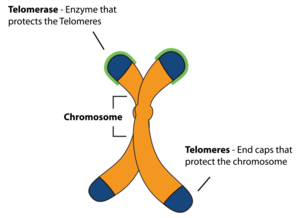Addition of Telomerase to Somatic Cells: Difference between revisions
No edit summary |
No edit summary |
||
| Line 6: | Line 6: | ||
==Section 1 Genetics== | ==Section 1 Genetics== | ||
Include some current research, with at least one image.<br><br> | Include some current research, with at least one image.<br><br> | ||
==Section 2 Microbiome== | ==Section 2 Microbiome== | ||
Revision as of 23:15, 6 December 2019
Introduction
Telomerase is an enzyme that is able to regenerate telomeres. In humans, it is found in some tissues, such as male germ cells, activated lymphocytes, and certain types of stem cell populations. If present in somatic cells, it can turn them cancerous following mutation. Telomere shortening is one of the factors which contribute to aging so it is worthwhile to look into such an addition to develop anti-aging treatments.

Section 1 Genetics
Include some current research, with at least one image.
Section 2 Microbiome
Telomerase is a reverse transcriptase enzyme with its own RNA template. This makes it very similar to DNA viruses with the notable exception of capsids. Such similarities could be used to establish the idea that viruses may have fused with the cells of other organisms to give rise to telomerase in the course of evolution from the RNA world.[1]
Conclusion
Overall text length should be at least 1,000 words (before counting references), with at least 2 images. Include at least 5 references under Reference section.
References
Edited by Nafeez Ishmam Ahmed, student of Joan Slonczewski for BIOL 116 Information in Living Systems, 2019, Kenyon College.
